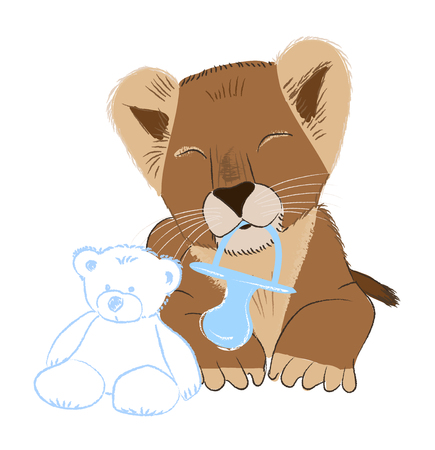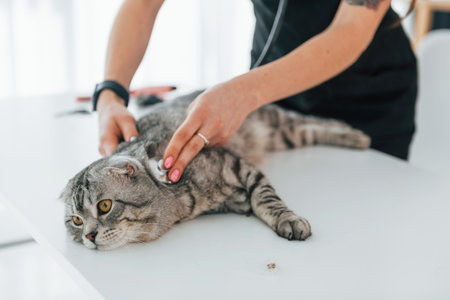Coat Differences Between Long-Haired and Short-Haired Cats
Understanding the differences between long-haired and short-haired cats is essential for proper grooming. Their coat structure, shedding patterns, and overall maintenance needs vary significantly. Let’s break down these differences to help you care for your feline friend effectively.
Fur Structure
The main distinction between long-haired and short-haired cats is the length and density of their fur. Long-haired cats, such as Maine Coons and Persians, have soft, flowing coats that can reach several inches in length. Short-haired breeds, like American Shorthairs or Siamese cats, have sleek, close-to-the-body fur that requires less daily upkeep.
Comparison of Fur Length and Texture
| Coat Type | Fur Length | Texture |
|---|---|---|
| Long-Haired Cats | 2-5 inches | Soft, fluffy, often prone to tangles |
| Short-Haired Cats | Less than 2 inches | Sleek, smooth, generally lower maintenance |
Shedding Patterns
Both long-haired and short-haired cats shed, but the amount and frequency vary. Long-haired breeds tend to shed year-round with seasonal increases, while short-haired cats may shed more noticeably during seasonal changes.
Shedding Frequency Comparison
| Coat Type | Shedding Frequency | Main Grooming Concern |
|---|---|---|
| Long-Haired Cats | Consistent shedding throughout the year with seasonal peaks | Mats and tangles due to longer fur trapping loose hair |
| Short-Haired Cats | More noticeable shedding in spring and fall | Loose hair accumulating on furniture and clothing |
Maintenance Needs
The difference in coat length also affects how much grooming each type of cat requires. Long-haired cats need daily brushing to prevent matting and reduce shedding. In contrast, short-haired cats typically only require brushing once or twice a week to keep their coat healthy.
Grooming Frequency Guide
| Coat Type | Brushing Frequency | Addition Care Tips |
|---|---|---|
| Long-Haired Cats | Daily brushing recommended | Use a wide-tooth comb or slicker brush; trim knots carefully if needed. |
| Short-Haired Cats | 1-2 times per week brushing is sufficient. | A rubber grooming brush helps remove loose hair effectively. |
The differences in fur structure, shedding patterns, and maintenance requirements highlight why grooming routines should be tailored to your cat’s specific coat type. Understanding these distinctions will help ensure that your cat remains comfortable and healthy while keeping excess fur under control.
Brushing Techniques and Frequency
Proper brushing is essential for keeping your cats coat healthy, reducing shedding, and preventing mats and hairballs. The frequency and tools you use will depend on whether your cat has long or short hair.
How Often Should You Brush Your Cat?
| Coat Type | Brushing Frequency |
|---|---|
| Long-Haired Cats | Daily or at least 4-5 times per week |
| Short-Haired Cats | 2-3 times per week |
Recommended Brushing Tools
The right tools make grooming easier and more effective. Here are the best brushes for each type of cat:
- Slicker Brush: Ideal for long-haired cats to remove tangles and prevent mats.
- Wide-Tooth Comb: Helps detangle fur and is great for long-haired breeds.
- Bristle Brush: Works well for short-haired cats to remove loose hair and distribute natural oils.
- Rubber Grooming Glove: A gentle option that helps remove loose fur while petting your cat.
The Best Brushing Practices
Create a Routine
Cats thrive on routine, so try to brush them at the same time each day or week. Reward them with treats to make the experience positive.
Brush in the Direction of Hair Growth
Avoid irritating your cat’s skin by always brushing in the direction their fur naturally grows. For long-haired cats, start with a wide-tooth comb before using a slicker brush.
Paw Attention to Problem Areas
Mats often form behind the ears, under the legs, and around the tail. Pay extra attention to these areas when brushing long-haired cats.
Prevent Hairballs with Regular Grooming
Cats groom themselves by licking their fur, which can lead to hairballs. Regular brushing removes loose hair before your cat swallows it, reducing hairball formation.
If Mats Form, Be Gentle
If you find a mat, don’t pull on it. Instead, gently work through it with a wide-tooth comb. For severe mats, consult a professional groomer.

3. Bathing and Hygiene Needs
Keeping your cat clean is an essential part of grooming, but the approach differs depending on whether you have a long-haired or short-haired breed. While cats are generally good at grooming themselves, occasional baths can help remove dirt, oil buildup, and loose fur—especially for long-haired cats who are more prone to tangles and matting.
When to Bathe Your Cat
Most short-haired cats rarely need baths unless they get into something sticky or dirty. Their natural grooming habits usually keep their coats in good condition. Long-haired cats, on the other hand, may benefit from occasional bathing every 4-6 weeks to prevent excessive oil buildup and matting.
| Cat Type | Recommended Bathing Frequency |
|---|---|
| Short-Haired Cats | Only when necessary (e.g., if dirty or oily) |
| Long-Haired Cats | Every 4-6 weeks to prevent matting and oil buildup |
How to Bathe Your Cat
Cats aren’t typically fond of water, so making bath time as stress-free as possible is key. Here are some steps to follow:
Step 1: Prepare the Bath Area
- Use a sink or a small tub with lukewarm water (never too hot or cold).
- Place a rubber mat or towel in the tub to prevent slipping.
- Have all necessary supplies ready before starting (shampoo, cup for rinsing, towel, brush).
Step 2: Use a Cat-Safe Shampoo
- Avoid human shampoos—they can dry out your cat’s skin.
- Select a mild, fragrance-free cat shampoo designed for their coat type.
- If your cat has sensitive skin, consider a hypoallergenic formula.
Step 3: Gently Wash and Rinse
- Lather the shampoo gently into their coat, avoiding the face and ears.
- Use a cup or handheld sprayer to rinse thoroughly—leftover soap can cause irritation.
- Towel-dry immediately after rinsing to remove excess moisture.
Tips for Keeping Your Cat’s Coat Clean Between Baths
- Regular Brushing: Brushing removes dirt and loose fur before it becomes a problem. Long-haired cats should be brushed daily, while short-haired breeds only need brushing once or twice a week.
- Paw and Face Wipes: Use pet-safe wipes to clean areas that get dirty often, like paws and under the chin.
- Dander Control Sprays: These sprays help reduce shedding and keep your cat’s coat fresh between washes.
- Litter Box Maintenance: A clean litter box prevents dirt from getting trapped in their fur—especially for long-haired breeds prone to messier rear ends.
Best Products for Long-Haired Cats
If you have a long-haired cat, certain products can make hygiene maintenance easier:
- No-Rinse Shampoo: A waterless shampoo can help freshen up their coat without the stress of a full bath.
- Dematting Spray: Helps loosen tangles before brushing to prevent painful knots.
- A High-Quality Brush: A slicker brush or wide-tooth comb is ideal for preventing mats and keeping fur smooth.
Bathing isn’t always necessary for every cat, but knowing how and when to do it can keep your feline friend looking and feeling great!
Managing Shedding and Hairballs
Cats naturally shed their fur, but long-haired and short-haired breeds have different shedding patterns and grooming needs. Proper care can help minimize loose hair around your home and reduce hairball formation, keeping your cat healthier and more comfortable.
How to Reduce Shedding
Shedding is a normal process, but excessive shedding can be managed with the right approach. Here are some effective ways to control it:
Regular Brushing
Brushing your cat helps remove loose fur before it ends up on your furniture or in their stomach.
| Coat Type | Recommended Brushing Frequency |
|---|---|
| Long-Haired Cats | Daily to prevent matting and excessive shedding |
| Short-Haired Cats | 2-3 times per week to remove loose fur |
Proper Nutrition
A balanced diet rich in omega-3 and omega-6 fatty acids promotes healthy skin and reduces excess shedding.
- High-quality protein: Supports strong, healthy fur growth.
- Fatty acids: Found in fish oil and flaxseed, these nutrients help maintain a soft and shiny coat.
- Hydration: Ensure your cat drinks enough water to support skin health.
Preventing Excessive Hairball Formation
Cats groom themselves frequently, which leads to hair ingestion. If too much fur accumulates in their digestive system, it can result in hairballs. Here’s how you can help prevent them:
Grooming Habits
- Frequent brushing: Reduces the amount of loose hair your cat swallows while grooming.
- Using deshedding tools: Helps remove undercoat fur that regular brushes may miss.
- Wiping with a damp cloth: After brushing, wipe down your cat to pick up any remaining loose hairs.
Dietary Adjustments
- Add fiber-rich foods: Fiber aids digestion and helps move ingested hair through the system more easily.
- Hairball control treats: Some commercial treats contain ingredients that promote natural elimination of swallowed fur.
- Laxative supplements: Special gels or pastes designed for cats can help reduce hairball buildup.
Encouraging Hydration
Cats that drink more water tend to experience fewer hairballs. Consider providing a pet water fountain to encourage drinking, as many cats prefer moving water over stagnant bowls.
By maintaining proper grooming habits and making slight dietary adjustments, you can significantly reduce shedding and prevent excessive hairball formation, ensuring your cat stays comfortable and healthy.
5. Dealing With Mats and Tangles
Long-haired cats are more prone to mats and tangles, which can cause discomfort and even skin issues if not addressed properly. Short-haired cats, while less likely to develop severe mats, can still experience minor tangles. Here’s how to handle these issues effectively.
Preventing Mats in Long-Haired Cats
Prevention is key when dealing with mats in long-haired cats. Regular grooming helps reduce the risk of tangled fur and keeps your cat comfortable.
Best Practices for Preventing Mats
- Daily Brushing: Use a wide-toothed comb or slicker brush to remove loose fur and prevent knots from forming.
- Regular Trims: Trim areas prone to matting, such as behind the ears, under the legs, and around the tail.
- Use a Detangling Spray: A pet-safe detangling spray can help loosen minor knots and make brushing easier.
- Check for Trouble Spots: Pay close attention to areas where friction occurs, like under the collar or around the armpits.
How to Safely Detangle Fur
If you find small tangles in your cat’s fur, follow these steps to remove them gently:
- Start with Your Fingers: Gently separate the tangle using your fingers before using a comb.
- Use a Wide-Tooth Comb: Work from the tip of the hair toward the base to avoid pulling on the skin.
- Add a Little Cornstarch: Sprinkling cornstarch onto the mat can help loosen it up before brushing.
- Avoid Cutting Mats Yourself: Unless you are experienced, cutting mats can accidentally injure your cat’s skin.
When to Seek Professional Grooming Services
If your cat has severe matting that cannot be brushed out safely, it may be time to seek professional grooming help. A groomer can remove stubborn mats without hurting your pet.
| Mild Tangles | Moderate Mats | Severe Matting |
|---|---|---|
| Easily removed with a comb | Takes extra time but can be worked out with patience | Mats are too tight or close to the skin; professional help needed |
| No discomfort for your cat | Your cat may show mild irritation during brushing | Mats may cause pain or skin irritation |
| No need for professional grooming | Might need detangling spray or special tools | A groomer or vet should handle removal |
If you notice your cats skin becoming red or irritated due to matting, consult a veterinarian or groomer as soon as possible. Keeping up with regular grooming will ensure that your cat stays happy, healthy, and mat-free!


